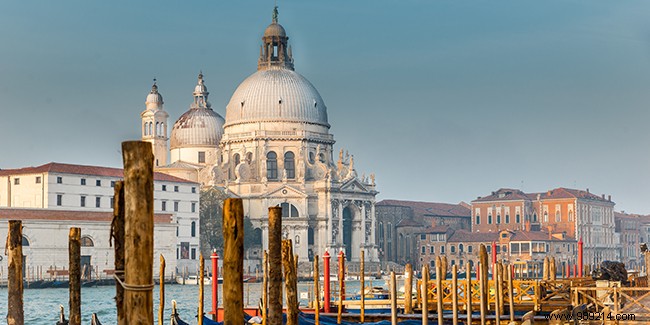
You want to go away as a couple, for a long weekend in Venice, or even alone or with your family. In any case, the idea is excellent, because the city on stilts is a delight for the eyes at every street corner or rather canal.
It was in 568 that Venice was founded by residents of the surrounding area fleeing the invasion of the Lombards. They began to drive oak and alder stakes into the marshy area to build their homes. Thus, warships could not access it. Venice was then a city of protection and a doge was elected there (first duke).
The best time to travel to Venice and visit it as it deserves is from the middle of March when it starts to get quite mild and when the crowds of the carnival have passed. In addition, during this period, you will benefit from cheaper plane tickets. Hotel rooms (always expensive or even very expensive) are also more affordable.
For a long weekend, you have no time to lose and you must find a hotel room in the city and name in another city, because access to the city is particular because Venice is on the water. Search the Internet for a small hotel behind St. Mark's Square. At this time of year, you will find room for around €100 per night. You can still opt for a B&B in the same area. If you want to spend a romantic weekend, mark this event and don't have a restricted budget, then opt for the Danieli along the Grand Canal and next to the Doge's Palace. Count around €400 per night during this period, but to spend a stay in this mythical palace hotel, the game is worth the effort. Once there, enjoy the wonderful breakfasts that will be presented to you and equip yourself with good shoes to go on a visit.
Located in Saint Mark's Square, the Doge's Palace is one of the symbols of the city, but also its political cradle. It was a fortified castle until 1173 and then housed the doges who were the most important political figures in Veneto. The doge presided over councils, receptions of ambassadors and official dinners. As you enter, admire the Carta door adorned with the lion of Saint Mark. Inside the palace, you will be able to admire 1,000 years of history with secret meeting rooms, a prison, hidden offices, but also period splendours.
Although the Patron Saint of Venice was Saint Theodore, in 828 two Venetian merchants brought back the body of Saint Mark. From then on, he became the new patron saint of the city. A small chapel was built for the occasion in the Doge's Palace. In 832, a small mausoleum church was built. It was destroyed several times and in 1063, a sanctuary was built. The basilica was consecrated in 1094. It then evolved between the 11th and 15th centuries to become the city's cathedral in 1807 with more than 4,000 m² of mosaics and 500 columns. By visiting it, you will discover its different styles, witnesses of its history over the centuries and of its unparalleled splendour.
The Saint Marc bell tower dominates the lakeside city from the top of its 98.6 meters. If you want to visit it, take your breath and climb the stairs to discover the breathtaking panorama of the city that awaits you at the top. If you can't make this climb, don't be frustrated and go to the San Giorgio bell tower which also offers you a great view, but which is equipped with an elevator.
The Bridge of Sighs is very famous. From the outside, you can see that it spans a canal and connects two buildings. In fact, it connects the prisons to the Doge's Palace and dates from 1602. It bears this name because of two prisoners who sighed while looking outside through the windows and who, it seems, strongly regretted their freedom.
In the 16th century, Jews in Veneto were required to wear yellow clothing and were prohibited from practicing most trades. They were then locked up every evening on an island called Gheto, whose name then became infamous. The Jewish quarter Cannagerio “the Ghetto” is to be seen. The atmosphere there is special. You can discover the fundamental della Sella, dell'Abazia, dei Mor and Madonna de l'Orto. The museum and the synagogues are to be seen at least once in a lifetime.
The Rialto Bridge was built in 1591. It spans the Grand Canal with only three more recent ones. The Rialto Bridge is a Venice institution, as it is the ancestor of credit and banking. This is where boat shares, foreign and Venetian currencies were exchanged. Rebuilt several times, the Rialto Bridge is 48 meters long, has three pedestrian crossings and two rows of shops. On each side, the reliefs bear the effigy of the two patron saints of the city, Theodore and Marc.
The La Fenice theater was built in the 18th century. Along with La Scala in Milan, it is one of the most prestigious theaters in the country. On the spot, many major creations have emerged. They are signed by Verdi, Donizetti, Bellino or Rossini. You can admire the hall, the stage and the royal box, but the best is to attend an opera, a concert or a ballet.
If you have a little more time, go to the Accademia Gallery where you can see Venetian works from the 12th to the 19th century. The Santa Maria della Salute church is also worth a visit. Lose yourself in the small streets to discover magnificent private palaces. You can also take the vaporetto to visit the emblematic islands of Burano, Murano, Tréporti, etc. Everything in Venice is magnificent and you will come back from your stay with your head still full of dreams for many, many years to come.